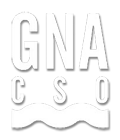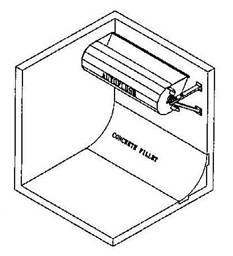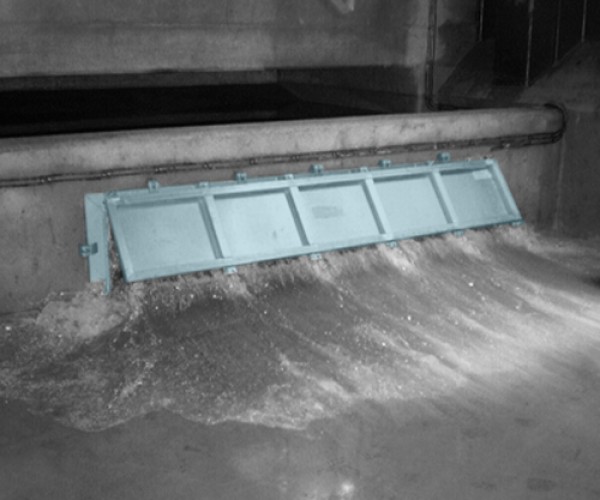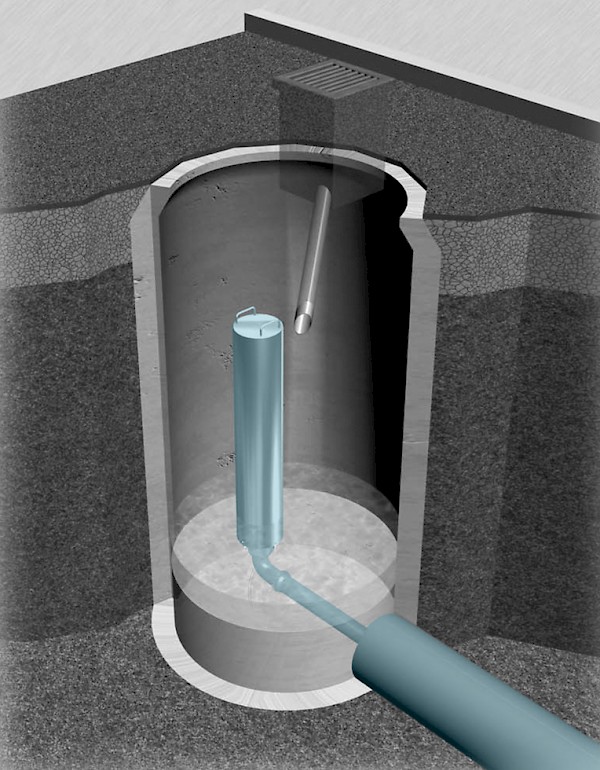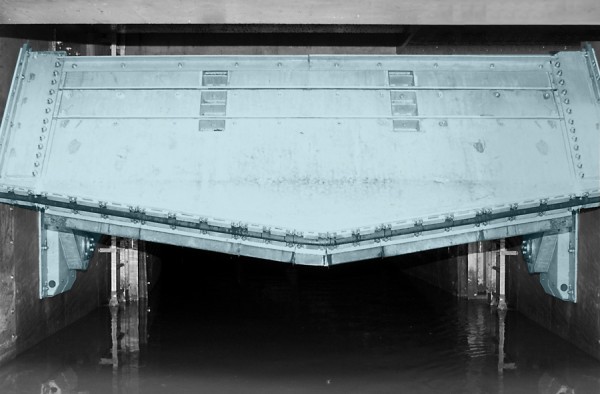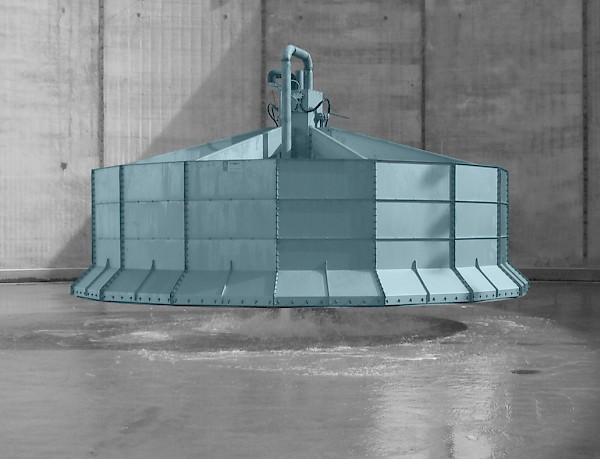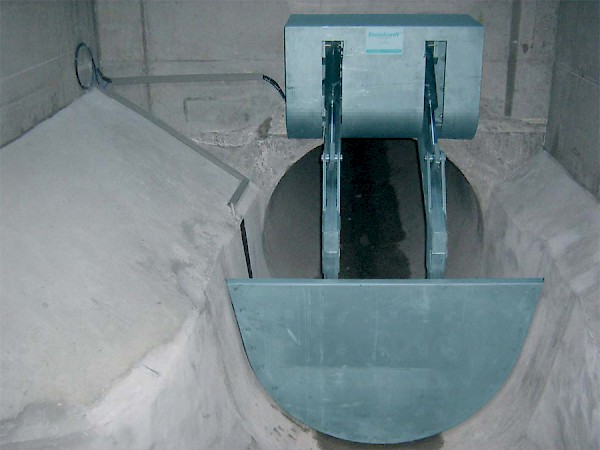AutoFlush
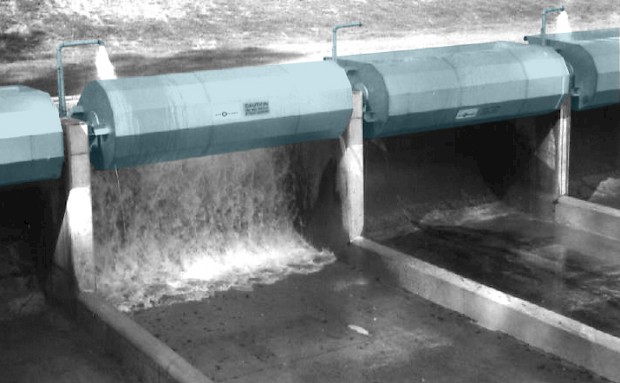
Introduction
The cleaning of storm water retention tanks as well as waste water equalization basins has always been a time consuming and costly endeavor. The need to send maintenance crews into these types of tanks represents a high risk due to the presence of gases which are caused by the settled matter. The need for a simple, efficient and reliable method of cleaning these tanks has always been present but the solution has not. The AUTOFLUSH solids removal device resolves these problems.
Advantages
The AUTOFLUSH is the most recently developed type of solids removal device available on the market. It incorporates the best and most reliable attributes of all other types of flushing devices thus offering the user a simple, efficient and economical method of cleaning the settled debris accumulated during the storage of excess flows. These advantages are:
- Streamlined design
- Constructed entirely in 304 or 316 stainless steel
- Economical and simple to install support system in new or existing tanks
- Forward or backward tipping
- Unlimited flushing length
- Maintenance free
- Waterproof bearings
- Easy installation
- Can operate with any available water supply
- AUTOFLUSH may be submerged
Operation
The new and improved AUTOFLUSH consists of a specifically designed geometric shape which rests in a horizontal position when the device is empty. When the water supply is activated the filling process begins, up to a pre-determined level. At this point and because of its specific shape, the centre of gravity of the device shifts thus causing the solids removal device to tip backwards or forwards, depending on the arrangement chosen, spilling its contents on the back-wall and thus giving rise to a high celerity wave which in turn removes all the settled debris which have accumulated on the bottom of the tank. After having spilled its content, the AUTOFLUSH device returns to its original position and is ready to operate again. The filling time for the solids removal device is dependent on the volume of the device as well as on the filling rate. Average fill time is 10-15 minutes. One flush is required for most applications under normal loading conditions. For excessively high loading conditions or for open air tanks left un-flushed for a few days, more than one flush may be required.
Basin Construction
The AUTOFLUSH solids removal devices can be installed in most tanks except circularly shaped tanks. The configuration of the basin will influence the overall cost of the installation but will not affect the efficiency of the operation. For new installations, if there are no constraints on the configuration of the tank, the ideal ratio of length to width should be anywhere from 3:1 to 5:1, i.e. the length should be three to five times longer than the width. The slope of the flush-way should be between 1% to 5%. Below 1% slope, the formation of puddles is a possibility. Above 5%, while there is no significant reduction in the volume of the solids removal device, the tank may become slippery and dangerous as well as adding extra civil costs to the overall project. Each flush-way should be equipped with a sump with a capacity equal to or greater than the volume of the solids removal device, in order to prevent the water carrying the settled debris from spilling back onto the tank floor. The manufacturer should be consulted for the most efficient dimensions of the tank as well as those of the sump.
Support System
The AUTOFLUSH solids removal devices are designed for quick and easy installation in new or existing tanks. They may be designed with one of three different support systems which may be fixed to the tank structure using either the back-wall, the side walls or the roof slab of the tank. The supports may be fixed in place using either HALFEN™ anchors (for new installations) which permit for horizontal adjustments or chemical anchors (for existing installations) which may be accurately installed into existing concrete. The supports are designed so that they are shipped ready to install and all bolts, nuts, washers, etc. necessary for a proper installation are also supplied. All support items are supplied in stainless steel 304 and are specifically designed for each device size and installation type (back-wall, sidewalls or roof slab). The different three types of support are shown in the following figure.
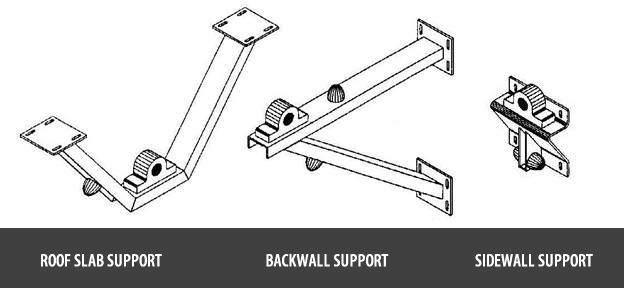
Bearings
Each AUTOFLUSH solids removal device is equipped with two bearings allowing for axial rotation of the device when filled. The bearings are SKF double tapered roller bearings in a split cast iron housing. The bearings are selected so that the loadings, both static and dynamic, do not exceed the load capacity. They are permanently lubricated using waterproof grease and require no on-site maintenance. Each bearing is factory installed and tested ensuring that the devices are ready to install when they arrive on-site.
Controls
The AUTOFLUSH solids removal devices may be installed to operate manually or be completely automated according to user preference. A completely manual system requires no electricity and only a water supply with a manually operated isolation valve. Once the tank has been emptied, the tank floor may be cleaned. An operator opens the isolation valves sequentially to the flushing devices and allows them to fill, tip and flush the floor of the tank, at which time the valves are shut and the cleaning procedure is complete.
The devices can also work in a fully automated mode by adding solenoid controlled valves, position indicators, water level indicators and a control panel. The solenoid valves are placed along the water supply line so that the flush water may be remotely activated. The position switches are placed on the support systems so that the orientation of the device may be noted at any given time and the water level indicator is used to know whether the tank has been activated as well as when the tank is drained so that the automated system may be activated. The solenoid valves are of standard type with a diameter that matches that of the water supply. The position switches may be standard lever switches or non-contact magnetic switches and may be either waterproof or explosion proof, but not both. It should be noted that waterproof switches may be made to be explosion proof by feeding their signal through an intrinsically safe relay housed in the control panel itself.
